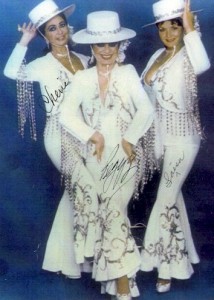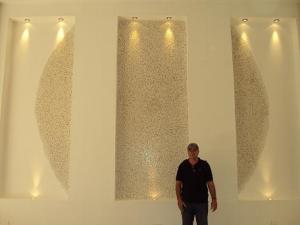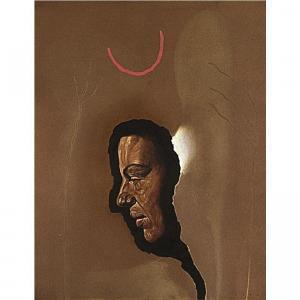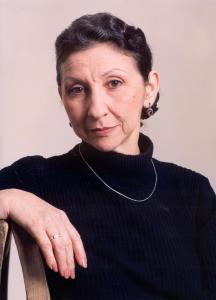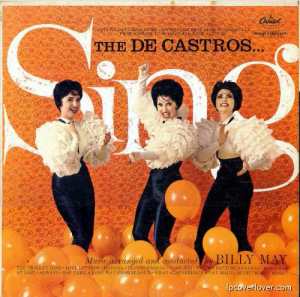 The DeCastro Sisters was a female trio singing group: originally they consisted of Peggy DeCastro (1921–2004), Cherie DeCastro (1922–2010) and Babette DeCastro (1925–1992). When Babette retired in 1958, a cousin, Olgita DeCastro Marino (1931–2000) replaced her and when Peggy later left the group to go solo, Babette re-joined Cherie and Olgita. Peggy eventually returned and Babette once more retired.
The DeCastro Sisters was a female trio singing group: originally they consisted of Peggy DeCastro (1921–2004), Cherie DeCastro (1922–2010) and Babette DeCastro (1925–1992). When Babette retired in 1958, a cousin, Olgita DeCastro Marino (1931–2000) replaced her and when Peggy later left the group to go solo, Babette re-joined Cherie and Olgita. Peggy eventually returned and Babette once more retired.
They began as a Latin-flavored trio, strongly inspired by The Andrews Sisters and were protegees of Carmen Miranda. They eventually became more Americanized in their performances and added a lot of comedy, but continued to have a unique and exotic identity of their own.
The biggest hit single for the group was “Teach Me Tonight”, in 1954. The song hit #2 in the United States, and the follow-up, “Boom Boom Boomerang”, hit #17. The group is referenced in an episode of The Sopranos, “Do Not Resuscitate”, as one of the only music groups that matriarch Livia actually likes, along with Mario Lanza.
The three original DeCastro Sisters—Peggy, Cherie and Babette—were raised in Havana in a family mansion that was seized by Fidel Castro during the Cuban revolution and is now used as the Chinese Embassy. Their mother, Babette Buchanan, was a Chicago-born Ziegfeld Follies showgirl who married the wealthy Cuban Juan Fernandez de Castro, owner of a sugar plantation in the Dominican Republic where Peggy was born.
De Castro later developed radio and television in Cuba with David Sarnoff, who was often a guest at their home and was also in charge of a planned project under the Batista regime to build a canal through Cuba, which never materialized.
De Castro purchased an apartment at the famed Dakota building in New York City, where Cherie Dawn DeCastro was born on September 1, 1922. Youngest daughter Babette was born back in Havana. The De Castro Sisters, always strongly chaperoned, began their singing careers as young girls and patterned themselves as a Cuban version of the Andrews Sisters. They emigrated to Miami in 1942, where they were seen by an agent from General Artists Corporation (now ICM) and booked into the Copacabana in New York with the Will Mastin Trio featuring another Cuban descendant artist Sammy Davis Jr.
As their careers took off, their act became more flamboyant and they worked across the country including the Palladium in Hollywood, where they sang with Tito Puente’s band and made their first recordings. In 1946, they provided several of the bird and animal voices for Walt Disney’s animated “Song of the South”, including the Oscar-winning “Zip-a-Dee-Doo-Dah”. They appeared on screen with Carmen Miranda and Groucho Marx in the 1947 film Copacabana, the same year that they joined Bob Hope and Cecil B. DeMille on the live premiere broadcast special launching KTLA in Los Angeles, the very first telecast west of the Mississippi. The sisters were introduced by Hope and sang “Babalu,” which was filmed by a Paramount newsreel cameraman and is the only surviving footage of the original three-hour show.
In 1954, a more Americanized version of the DeCastro Sisters, were signed by a small country label, Abbott Records, and their first release featured “It’s Love” as the A-side, backed by an obscure Sammy Cahn-Gene DePaul song, “Teach Me Tonight”, that had been suggested at the last minute by their bass player. The label was pushing “It’s Love,” but Cleveland disc jockey Bill Randall turned the record over and “Teach Me Tonight” soon took the nation by storm, peaking at No. 2 on the charts and selling more than five million copies to date. Several more recordings followed including “Too Late Now”, “Boom Boom Boomerang”, “Snowbound For Christmas”, “With My Eyes Wide Open I’m Dreaming,” and numerous albums on a variety of labels including RCA Victor, ABC-Paramount, Capitol, and 20th Century-Fox.
Now major headliners, they shared the bill with Noël Coward when he made his Las Vegas debut at the Desert Inn in 1954, which had one of the most star-studded and publicized opening nights of any show in the town’s history. Coward would watch their act every night while waiting to go on himself. They were part of another historic engagement in 1959, when they joined the Las Vegas debuts of George Burns as a solo act and a young singer named Bobby Darin at the Sahara. It was the DeCastros who told Darin that he should record one of the featured songs in his act, “Mack the Knife” Darin thought it was just a nightclub number, but he later took their advice.
The DeCastro Sisters appeared on most major TV shows including The Ed Sullivan Show and The Perry Como Show. They also made numerous film shorts including Universal’s “Swingin’ and Singin'” with Maynard Ferguson and Riot in Rhythm with Harry James. At various times Peggy and Babette took leave from the act and were replaced by a cousin Olgita, so Cherie was the only sister who was part of every appearance and recording that the group ever made.
In 1997, they were part of KTLA’s 50th anniversary broadcast in Los Angeles and headlined at the Hollywood Roosevelt’s Cinegrill. Three years later, they were inducted in the Casino Legends Hall of Fame as “Las Vegas Living Legends.” Cherie continued to perform until shortly before her illness and sang “Teach Me Tonight” on the 2006 PBS special, “My Music: Moments To Remember”, which is still periodically shown and is out on DVD.
DEATH.
Babette died of cancer in 1992. Olgita died of asthma on February 14, 2000. Peggy DeCastro, the oldest member of the DeCastro Sisters died of lung cancer on March 6, 2004 in Las Vegas, she was 82. Cherie, the only sister to appear on every recording, film, TV and stage appearance, died on March 14, 2010.
She was 87. DeCastro died at Valley Hospital Medical Center in Las Vegas.
Agencies/Various/Wiki/InternetPhotos/youtube/thecubanhistory.com
The Cuban History, Hollywood.
Arnoldo Varona, Editor.




